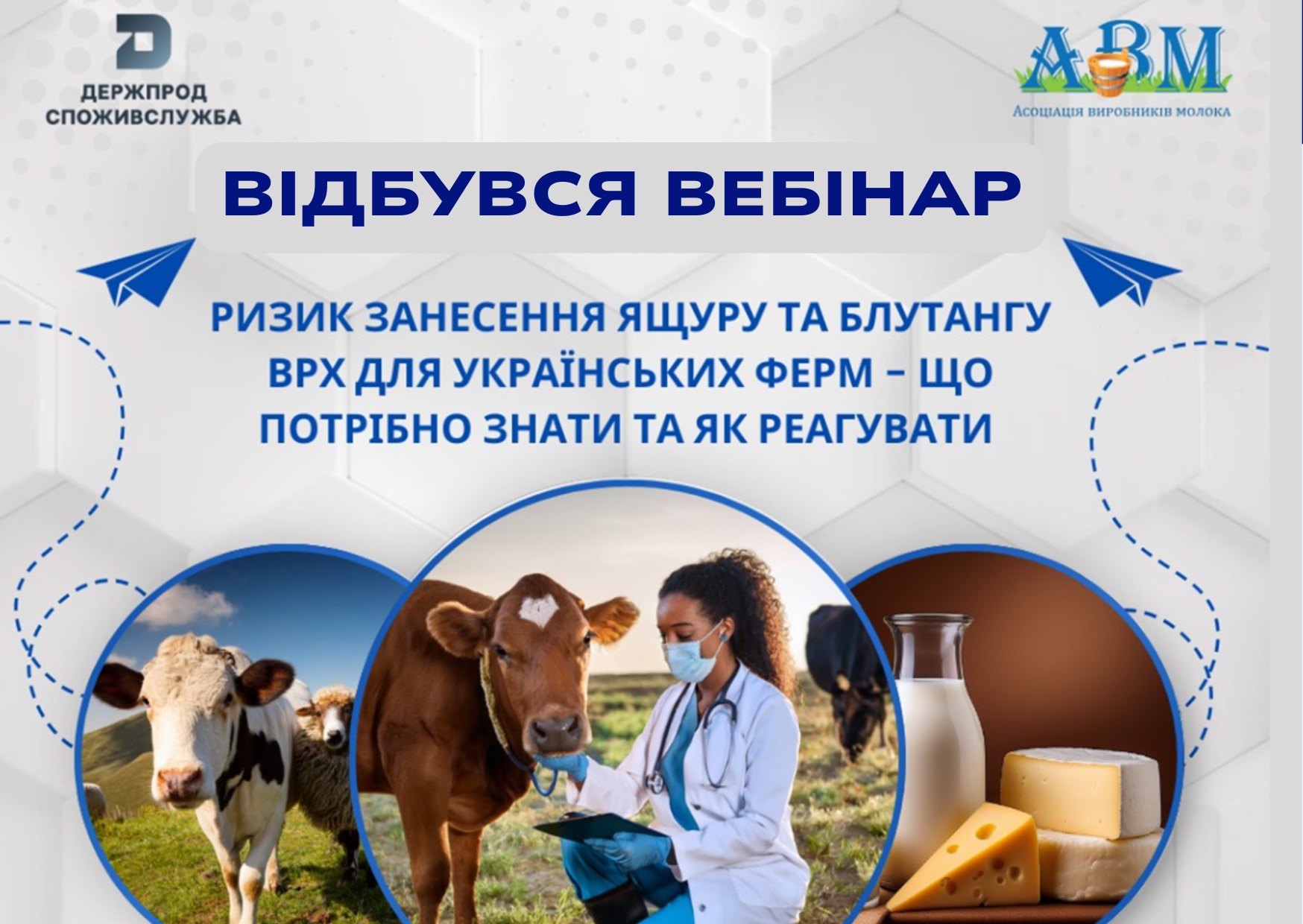On April 7th, an initiative of the State Service of Ukraine for Food Safety and Consumer Protection, the Committee on Food Safety and Veterinary Medicine of the Public Council of the State Service of Ukraine for Food Safety and Consumer Protection, in cooperation with the Association of Milk Producers of Ukraine (AMP) and the Consulting Center of AMP, held a free webinar for the dairy community of Ukraine. The goal was to provide updated information on the spread of foot-and-mouth disease and bluetongue in the EU, the risks for Ukraine, disease symptoms, effective prevention measures, and action plans for farms and local service representatives in case of suspected or confirmed outbreaks.
The webinar was attended by 500 participants – the maximum number allowed for registration (for those who could not connect, a recording of the webinar and presentation materials are attached below). The event featured Volodymyr Kusturov, Deputy Head of the State Service of Ukraine for Food Safety and Consumer Protection, acting as the Chief State Veterinary Inspector of Ukraine; Oleksiy Klymenko, Head of the Animal Health and Welfare Department of the Department of Food Safety and Veterinary Medicine; and Marian Trotskyi, Head of the Committee on Food Safety and Veterinary Medicine of the Public Council of the State Service of Ukraine for Food Safety and Consumer Protection. The moderator was Valeriy Lototskyi, a leading expert in cattle breeding and reproduction, and Director of the Consulting Center of AMP and the Center for Veterinary Service (CVS).
Given that foot-and-mouth disease has not been recorded in Ukraine since 1988, and since 1992 Ukraine has had OIE status as a country free from vaccination, meaning animal vaccination is not carried out, it was emphasized during the webinar that livestock owners should be especially vigilant and implement appropriate biosecurity measures.
How to Recognize Foot-and-Mouth Disease?
The clinical signs of foot-and-mouth disease depend on the virus strain, age, species, and breed of the infected animals. Sick animals show lesions with erosions (aphthae) on the inner surface of the oral cavity, tongue, udder, and limbs. Other signs include salivation, anorexia, lameness, decreased appetite, fever, abortion, sudden death of newborn young animals, and reduced milk production.
Humans can also get foot-and-mouth disease. The main route of infection for humans is through the consumption of raw milk from animals infected with the foot-and-mouth disease virus, as well as through its processed products, and less frequently through meat. Direct transmission of infection to humans via airborne droplets is possible upon contact with a sick animal. Humans can shed the virus in the respiratory tract for 24-48 hours. In light of this, farm owners are urged to be prepared for potential risks and to arrange in advance for the food and accommodation of workers who may potentially carry the virus.
The main source of infection is animals sick with foot-and-mouth disease and animals in the incubation (hidden) period of the disease. Infected animals transmit the virus through breathing, saliva, nasal mucus, lymph from ruptured blisters, milk, urine, and feces. Infection occurs through direct contact of sick animals with healthy ones. From the moment of infection to the appearance of the first clinical signs, it takes 7 to 14 days in cattle and 21 days in other susceptible animals. In the environment, the foot-and-mouth disease virus can remain viable for an average of three months or less. The stability of the virus increases at lower temperatures, potentially lasting up to six months.
To prevent the occurrence of the disease, it is necessary to adhere to biosecurity measures:
- Maintain strict control over the access of people, vehicles, and equipment to the herd.
- Ensure regular disinfection of animal housing, equipment, clothing, and footwear.
- Ensure proper disposal of manure and waste.
- Users of hunting grounds of all forms of ownership should report any discovery of dead wild cloven-hoofed animals to the state veterinary medicine service of the district.
- Continuous monitoring of the health status of animals.
If signs of illness or unusual animal behavior are detected, and in the case of mass death of animals, it is necessary to immediately notify the local veterinarian or the territorial body of the State Service of Ukraine for Food Safety and Consumer Protection.
Detailed explanations regarding the symptoms, consequences, ways to prevent infection, and a clear algorithm of actions in case of suspicion or confirmation of the disease are available in the video recording of the webinar below or via the link on the AMP YouTube page: https://www.youtube.com/watch?v=zQbly2Spty0
Press Service of the Association of Milk Producers
Follow us on Facebook
Related News
Foot-and-Mouth Disease Creates Price Risks for Europe's Dairy Industry


